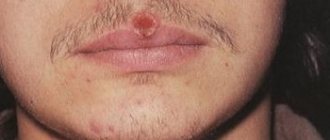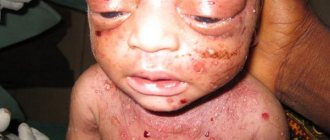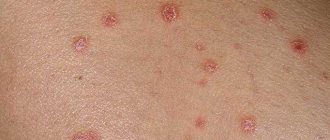Syphilis
The examination methods are chosen by the doctor taking into account the patient’s general health, the presence of complications and the stage of the disease. Which doctors should I contact?
Women are consulted by a gynecologist, men by a urologist or dermatovenerologist. Consultations with other specialists are recommended in the following cases:
- pediatrician, ophthalmologist, neurologist, otorhinolaryngologist - for children with suspected congenital syphilis;
- ophthalmologist and neurologist - for all patients with syphilis;
- if a specific lesion of internal organs, the musculoskeletal system, etc. is suspected, consult specialists in accordance with complaints or pathological changes detected during an instrumental examination.
Treatment of syphilis
Treatment of syphilis is successful in the early stages. First, therapy is carried out in a hospital, then on an outpatient basis. Complete recovery is confirmed by laboratory tests. Treatment is given to all sexual partners with whom the patient has had intimate contact within the last 90 days, and in the case of the secondary form - 12 months. If partners test negative for syphilis, they are prescribed preventive therapy.
Treponema pallidum is sensitive to antibacterial drugs of the penicillin group. The first loading dose technique is practiced - at the beginning of treatment, the medicine is administered intramuscularly in large volumes at short time intervals. A high concentration of the active substance is constantly maintained in the body. The drug of choice for the treatment of syphilis is benzylpenicillin. Ceftriaxone gives positive dynamics in the later stages of syphilis and can be used in the treatment of pregnant women. The antibiotic suppresses the reproduction of treponema. The course of injections is at least six months. In the case of secondary syphilis, before prescribing long-acting penicillins, broad-spectrum antibiotics (tetracyclines, macrolides) are prescribed for 2 weeks.
The dosage and duration of medication are calculated individually for each patient. Syphilis in latent form is treated comprehensively with the use of immunomodulators and physiotherapy. If there is a chancre with purulent discharge, it is recommended to supplement the treatment complex with local lotions, powders and ointments with an antibiotic.
Patients are warned about the body's possible reaction to treatment. Medical organizations where therapy is carried out must have emergency care facilities.
Complications
Intrauterine infection of the fetus from the mother is considered the most dangerous - in 40% of cases, pregnancy ends in the death of the child before birth or a few days after. The risk of miscarriage, development of congenital growth disorders of the skeleton, teeth, deafness, blindness, and severe brain damage increases many times over.
Complications of a neurological nature in patients with advanced forms of syphilis may include meningitis, urinary incontinence, stroke, a significant increase in the pain threshold and lack of temperature sensitivity, impotence in men, and deafness.
Syphilis affects the functioning of heart valves and changes the cells of functional tissues.
Often, patients with advanced infection are diagnosed with inflammation of the aorta and other blood vessels, and aneurysms are detected.
The greatest danger is represented by gummas - ulcers that form on the skin or internal organs and are not visible during examination. The formations can heal on their own or progress into weeping syphilis ulcers. In the places where gummas are located, tissues soften and rotting processes begin. Even the bones of the skull are affected. Gummas are extremely difficult to treat, so therapy is mainly aimed at maintaining the patient’s quality of life.
Deformation of bones and joints leads to external deformities - first of all, the cartilage of the nose is destroyed.
Serious side effects of treatment are also known:
- The exacerbation reaction (Jarisch-Herxheimer) begins 2-4 hours after the first administration of the antibacterial drug, reaches its maximum severity after 5-7 hours, and the condition returns to normal within 12-24 hours. The main clinical symptoms are chills and a sharp increase in body temperature, general malaise. Occasionally, patients may develop psychosis, stroke, seizures, and liver failure.
- A reaction to intramuscular administration of long-acting penicillin preparations (Hine's syndrome) can occur after any injection of the drug. Characterized by dizziness, tinnitus, fear of death, pallor, paresthesia, blurred vision, increased blood pressure, short-term loss of consciousness, hallucinations or convulsions may occur immediately after injection. Lasts within 20 minutes. Symptoms can vary in severity, from mild to severe.
- Nikolaou syndrome is a symptom complex of complications after intra-arterial administration of penicillin or other drugs with a crystalline structure. It is characterized by sudden ischemia at the injection site, the development of painful bluish uneven spots (livedo) followed by the formation of blisters and necrosis of the skin, in some cases flaccid paralysis of the limb into which the drug was injected develops, in rare cases - transverse paralysis. To date, cases have been reported only in pediatric practice.
- Neurotoxicity - seizures (more often in children) when using high doses of penicillin, especially in the presence of renal failure.
- Electrolyte imbalance - in patients with heart failure, when large doses of benzylpenicillin sodium salt are administered, edema may increase.
- Allergic reactions - toxicoderma, urticaria, Quincke's edema, headache, fever, joint pain, eosinophilia, etc. The most dangerous complication is anaphylactic shock, which has a mortality rate of up to 10%.
Prevention of syphilis Prevention of
syphilis includes sanitary education, screening examination of certain groups of the population, as well as full specific treatment followed by clinical and serological observation.
You can reduce the likelihood of infection if you use barrier contraception; If you have unprotected sexual intercourse with a casual partner, you should immediately carry out emergency anti-venereal prophylaxis (treating the skin and mucous membranes of the genital organs with special disinfectant solutions (chlorhexine, miramistin)).
Sources:
- Clinical recommendations. Syphilis. All-Russian public organization “Russian Society of Dermatovenereologists and Cosmetologists” (approved by the Ministry of Health of Russia), 2021. – 102 p.
- Sokolovsky E.V., Krasnoselskikh T.V., Rakhmatulina M.R. Federal clinical guidelines for the management of patients with syphilis. Russian Society of Dermatovenereologists and Cosmetologists, 2015. - 45 p.
IMPORTANT!
The information in this section cannot be used for self-diagnosis and self-treatment. In case of pain or other exacerbation of the disease, diagnostic tests should be prescribed only by the attending physician. To make a diagnosis and properly prescribe treatment, you should contact your doctor.
Causes of the disease
The causative agent of syphilis is Treponema pallidum or Treponema pallidum.
This bacterium resembles a spiral in shape, it can move, and reproduces by division. When it enters the body, it settles in the lymph nodes. It begins to show up in the blood much later. Treponema is practically unviable in the environment. It does not tolerate heat, light, or drying, but at room temperature it remains mobile for up to 12 hours. Sensitive to antibiotics and almost all antiseptics. But treponema tolerates low temperatures well. It is an anaerobic - it does not require oxygen to live and reproduce.
Most often, syphilis is transmitted sexually, which makes it possible to classify it as a sexually transmitted disease. This method of infection accounts for up to 98% of all diagnosed cases.
However, there are known facts of transmission from an infected person, as well as among drug addicts who use the same syringe when injecting drugs, in everyday life when using toothbrushes or razors with blood residues on them.
Household transmission of syphilis is extremely rare and most often occurs through close contact with a patient who already has tertiary syphilis. Treponema pallidum is found in saliva only in the presence of ulcers in the oral cavity, but is absent in urine, sweat and feces.
The cause of syphilis infection can be the milk of a woman nursing her baby. There are also known cases of transmission of the disease from a patient to a fetus during pregnancy.
Forecast
Prognostic data depends on many factors, including the identified stage of the disease, timeliness of treatment and the presence of additional diseases. Modern methods of therapy make it possible to eliminate the pathological condition before bacteria cause damage to internal organs, but in this case it is necessary to rely on timely diagnosis and screening studies. If the disease is detected, the patient must inform all sexual partners about the need for treatment.
Conditions that may negatively affect the prognosis:
- Transition of the disease into a latent form.
- Late or incomplete treatment.
- Tertiary form of syphilis with damage to internal organs and the nervous system.
- The presence of HIV infection in the patient.
- Old age of the patient.
- Congenital pathologies of the immune system.
As practice shows, early neurosyphilis develops much faster in patients suffering from HIV infection. It is imperative to inform the doctor about concomitant diseases in order to correctly select drug therapy.
Treatment
Drug therapy is selected individually after accurate laboratory confirmation of syphilis. Of the variety of antimicrobial drugs, doctors most often prescribe water-soluble penicillins to patients. Despite decades of use of penicillin derivatives as antibacterial therapy, Treponema pallidum has not acquired resistance to these drugs. The treatment regimen is selected in such a way as to maintain the optimal concentration of the drug in the patient’s blood. If an allergic reaction to penicillin derivatives is detected, the doctor selects other medications.
Other treatment options:
- Doxycycline. This antibiotic is an excellent alternative to penicillin derivatives and is suitable for the treatment of early and late latent syphilis.
- Erythromycin, tetracycline derivatives and cephalosporins when bacterial resistance to penicillin is detected.
- Derivatives of bismuth and arsenic in the tertiary form of infection. These are highly toxic drugs prescribed only after hospitalization.
To select therapy, it is advisable to contact a specialized clinic. During the consultation, the doctor will explain the treatment regimen to the patient, indicate the dosage of medications and the regimen. When using antibiotics, it is important to take your medications regularly. Self-treatment of syphilis is unacceptable due to the risk of developing dangerous complications.
Types of chancre
Chancre is an ulceration that occurs 3-90 (on average 21) days from the moment of infection with syphilis, more often in the area of penetration of the pathogen into the patient’s body.
First, a pink spot (inflammation) forms on the skin, then a dense nodule appears in this place, after 7-10 days it becomes necrotic and turns into an ulcer or erosion. If the resulting chancre is not accompanied by itching or pain, then it is called syphiloma. Syphiloma has a regular round or oval shape and clear boundaries that protrude above the skin. The edges are dense, roll-shaped. The bottom of the syphiloma is red, less often – meat-colored, maybe red-brown, and the chancre itself looks varnished, due to the characteristics of the wound.
The size of syphiloma varies from 5 to 30 mm, but there are ulcers of larger or smaller diameter. The main symptom of chancre is a cartilaginous compaction at the base of the ulcer, which can be felt upon palpation. When pressed, the chancre is painless. The skin around the ulcer is clean, without signs of inflammation.
Chancre is formed due to the penetration of Treponema pallidum (spirochete) into the body. For reproduction, the temperature of the human body is suitable for it and after entering the body it actively forms syphilomas. The chancre themselves can be of different types, shapes and sizes.
Classification
By quantity
Single - chancre in the form of a separate neoplasm, or multiple, which looks like several ulcerations.
By origin
Twin chancres occur during simultaneous infection - when the pathogen enters the patient’s body not in one, but in several “places”. That is, instead of one chancre, two or more can be found.
Chancres formed as a result of infection at different times. They appear one after another, in approximately the same place.
The so-called “kissing” chancre, which occurs on contacting surfaces.
Concomitant diseases can contribute to the formation of multiple syphilomas:
- scabies
- acne
- skin injuries
By depth of penetration into tissue
Syphilomas have different depths of tissue damage.
Ulcerative lesions affect the deep layers of the skin. They can pass through the dermis - right down to the subcutaneous tissue. I have a rough bottom covered with purulent plaque. Erosion is located closer to the surface. The bottom is smooth, shiny, and shaped like a saucer.
To size
In addition to standard sizes from 5 to 10 mm, there are giant and dwarf chancres.
Giant chancres are extremely rare and can reach up to 20 cm in diameter. They are localized mainly in areas of accumulation of fatty tissue: on the abdomen, thighs, and pubis. Syphilomas are called dwarf and are the size of a poppy seed - 1-2 mm; they can only be seen through a magnifying glass. They are rare.
By location
Chancre can be located on different parts of the body:
- genital syphilomas are located on the genitals
- extragenital - on any other parts of the body outside the genitals (Fig. 1)
- bipolar syphilomas occur simultaneously both on the genitals and outside the perineum.
Figure 1. Chancre on the index finger of the left hand and in the area of the inner corner of the left eye. Source: CC0 Public Domain
By shape
In addition to the classic round shape, chancre can have a different appearance.
Slit-shaped syphilomas look like cracks. They can form in the corners of the mouth, on the tongue, near the anus. They are rare. Located in the corners of the mouth, they can be perceived by the owner as non-dangerous “jams”.
Cortical chancre is not like ordinary syphilomas; it is not concave in shape and is covered with a crust. It usually forms on ulcers that are located in places where their contents dry out easily: the surface of the nose, face, corners of the mouth.
Diphtheritic chancre is covered with an ash-gray film, similar to diphtheria. Happens quite often. It can be localized in any area.
The burn chancre quickly increases in diameter, while its borders lose their regular shape and clear outline, and the bottom changes from smooth to red-grained (Fig. 2). Typically, primary syphilomas do not tend to grow. This is an exception.
Figure 2. Burn syphiloma. Source: CC0 Public DomainCaption
Erosive chancre includes many erosions; ulcers can merge. Formed exclusively on the mucous membranes of the genitals.
Chancroid herpetiformis is named for its resemblance to genital herpes. This is an erosive formation, in the field of which there are many small ulcers with clearly defined edges. Similar to Folman's balanitis, but in this case the ulcers do not merge.
Diagnostics
Several basic methods are used to detect syphilis:
- Detection of treponema pallidum using a microscope in a scraping taken from a chancre.
- The serological method (Wassermann reaction) - when specific proteins that are produced by the immune system in response to the appearance of treponemes in the body are determined, is not effective for primary syphilis.
- The microprecipitation reaction is a rapid diagnosis, also based on the body’s production of antibodies.
- Specific tests RIF, RIT, RPGA, etc. – difficult to set up, time-consuming and expensive. Used to identify latent syphilis, in complex atypical cases, in differential diagnosis and for the diagnosis of late syphilis.
If treponema is detected immediately using microscopy, additional studies are not required to prove infection. Upon detection of treponema, treatment is prescribed immediately.
Sometimes it is necessary to carry out a whole range of diagnostic measures to establish an accurate diagnosis, so it is impossible to diagnose the disease yourself; you need to consult a doctor.
Localization
Since syphilis is transmitted primarily through sexual contact, chancroid is most often localized on the genitals. However, clinical practice shows that syphilomas are almost as often found in the mouth and anus.
This means that chancre can appear anywhere, the place of its localization can be:
- penis and scrotum
- labia and clitoris
- posterior commissure and anal area
- pubis
- oral cavity: lips, gums, tongue and throat
- inner thighs
- chest and stomach
- face
- rarely - eyelids, conjunctiva of the eyes
Chancre can be located inside the genital organs, for example, on the walls of the vagina or cervix, then syphiloma is difficult to detect.
Complications
The course of syphilis negatively affects the condition of all organs and tissues, so untimely treatment can lead to serious negative consequences. Typically, doctors separately consider visceral and neurological complications of the disease. Neurosyphilis, characteristic of the secondary and tertiary periods of the disease, has early and late manifestations. The most severe forms of damage to the central nervous system occur 10-15 years after infection of the body. At the same time, due to the transition of the infection to a latent form, some patients stop treatment, as a result of which late neurosyphilis occurs.
Complications of late neurosyphilis and visceral syphilis:
- Damage to skeletal muscles, manifested by impaired voluntary movements.
- Deterioration of intellectual abilities, memory impairment.
- The emergence of psychotic disorders.
- Irreversible loss of vision and hearing.
- Syphilitic damage to the meninges (meningitis).
- The appearance of external deformities.
- Membranous glomerulonephritis.
- Severe damage to the cardiovascular system.
The prolonged course of syphilis is accompanied by a significant deterioration in the quality of life. After treating a disease of the secondary or tertiary period, the patient will require long-term rehabilitation to eliminate secondary diseases. It is important to understand that the development of disability may be the price of a careless attitude towards one’s own health.









